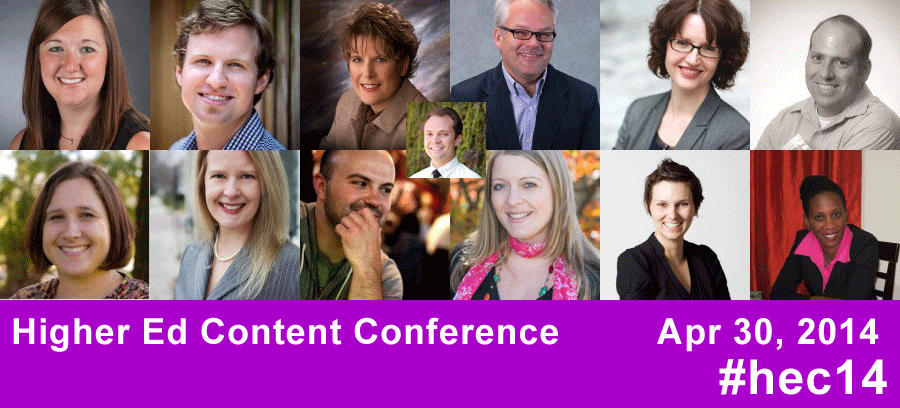Just starting out with Content Strategy?
No reason to feel bad about it. Most of us are beginners, anyway :-)
Only 3 years ago nobody was talking about content strategy in higher education and the other industries were just warming up to the discipline after the first edition of Content Strategy for the Web by Kristina Halvorson was published in August 2009.
Content strategy in higher education is still pretty new, but a great community has developed around content issues in higher education – always ready to share and help!
The 13 presenters of the 2014 Higher Ed Content Conference are a pretty helpful group. So, when I asked them to share a piece of advice to improve your digital content, they shared some great proven strategies.
 1) Focus on culture change – Mike Petroff, Digital Content Strategist at Harvard University
1) Focus on culture change – Mike Petroff, Digital Content Strategist at Harvard University
Improving digital content starts with improving the internal culture. Start by identifying projects that will help guide conversation around how digital technology is changing behaviors, and how the school’s content can be better prepared and served to meet the needs of the audience.
 2) Read “outside of the box” – Donna Talarico, Director of Integrated Communications at Elizabethtown College
2) Read “outside of the box” – Donna Talarico, Director of Integrated Communications at Elizabethtown College
Just like I’d advise a writer to read often, I’d tell someone who wants to improve his or her campus’ content to read, read, read digital content. Inspiration is everywhere, and looking at peer schools as well as OUTSIDE higher ed can get someone outside of that bubble. Know what else is out there. And, by all means, get active on Twitter (and follow the right people, of course) so you can get daily doses of inspiration and be connected to a network of smart cookies.
 3) Develop relationships on campus – Mandy Potts, Marketing and Communications Manager at UW Oshkosh
3) Develop relationships on campus – Mandy Potts, Marketing and Communications Manager at UW Oshkosh
They should start by becoming good friends with people around campus who can share with them what’s going on. The key to improving content—online or in print—is having strong relationships with people around your university who can help you find the good content and connect you with the sources.
 4) Do Online Audience Research – Chris Syme, Consultant
4) Do Online Audience Research – Chris Syme, Consultant
I think watching what the innovators are doing is important. I know that sounds weird on some level, but I love seeing case studies and examples of what people who are out on the front are doing. I want to see and be inspired to replicate or scale those ideas to my audience. Find some blogs that highlight case studies, read books that aren’t higher ed oriented like Youtility by Jay Baer, Renegades Write the Rules
by Amy Jo Martin, to keep up with current marketing trends. And most of all, be listening to and asking your audience what they want from you. If you’re not creating content based on what your audience wants, who are you expecting to consume the content? Audience research is totally underrated.
 5) Focus on your audience’s questions – Liz Babiak, Social Media Community Officer at Algonquin College
5) Focus on your audience’s questions – Liz Babiak, Social Media Community Officer at Algonquin College
Find out what your audience needs — what information are they asking for, what has them stumped — and create content to answer those burning questions.
 6) Use case studies to get buy-in – Cameron Pegg, Executive Officer at Griffith University in Brisbane (Australia)
6) Use case studies to get buy-in – Cameron Pegg, Executive Officer at Griffith University in Brisbane (Australia)
Attend this conference for a start! :-) There are many great highered digital content case studies out there which are both inspiring and instructive. Find those that match your vision, desired outcomes (or resources), and prepare a solid case that makes it easy for your boss to say yes. Good research is about new ideas backed up by evidence; why should digital content strategy be any different?
 7) Produce less content – Tabita Green, Director of Web Content at Luther College
7) Produce less content – Tabita Green, Director of Web Content at Luther College
Start with a solid style guide for your content.
Then do less in order to produce higher-quality content. For example, produce ten high-quality videos rather than forty sloppy/cheap ones.
8) Learn about usability – Marcy Gineris, Web Content Manager and Strategist at Eastern Mennonite University
Start at the beginning, from a user point of view. Too often academic content or architecture reflects an org chart or brochure copy. Talk directly to your user or visitor, and engage in the conversation from a usability standpoint. Learn more about user experience basics before you dig too deep into analytics.
9) Keep Calm – Klinita Burke, Campus Webmaster at The University of the West Indies, Cave Hill Campus
First thing: don’t get overwhelmed and don’t expect big changes overnight! Good content is as much about a culture shift – (traditionally academia and lengthy documents go hand in hand) as it is about understanding good content writing techniques. Arm yourself with knowledge, see what other universities are doing, remember your target audience.
10) Learn as much as you can – David Anderson, at UB School of Medicine and Biomedical Sciences
Learn the rules and mechanics of writing, even if you don’t write. You need to be able to give good advice about how you want your writers to write.
And learn as much as you can about what makes for effective photos. Too little attention is paid to the photos that are used on websites. There is a lot of research available about how we interact with photos: seek that out and apply it to your photos. If you only apply a tenth of the recommendations you find, you’ll be far ahead of the game.
 11) Go multimedia! – Rob Pasquinucci, Director of Communications at UC College of Arts and Sciences
11) Go multimedia! – Rob Pasquinucci, Director of Communications at UC College of Arts and Sciences
Embrace multi-media. A photo gallery, audio file or video can enhance any piece and adds a new dimension. Also, I’d recommend adopting an “always on” mentality – look at the day’s news and see where your faculty and their expertise fit in. It might be as simple as “5 things you didn’t know about the Ukraine” from a history or political science professor. Be nimble!
12) Use the 80/20 rule – Donna Lehmann, Director of Online Communications at Fordham University
The 80-20 rule. You hear this rule applied to social media — 80% of your social media content should be informational/educational with just 20% about your product or service — but it could be applied to most any web content. It helps content creators get outside themselves and think about content that isn’t merely about promoting their department or event.
13) Use personas – David May, Director of Web and Interactive Marketing at Chapman University
Create an imaginary person who fits one of your target audiences – actually create a word document, write a quick profile, bio, and even select a picture for your example audience member. Thinking of how to write for this specific person can be a great exercise. Next, take this Higher Ed Experts course (that is where I learned the ‘imaginary person’ trick)!
What about YOU? What’s your strategy to improve digital content?
Please, don’t be shy and share yours by posting a comment below!
And, if you want to learn more from these great higher ed social media professionals, make sure you sign up your team for the 2014 Higher Ed Content Conference (Apr 30, 2014).




